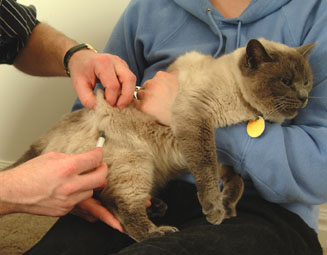
| Regular vaccination is the best way to prevent rabies in cats. |
Introduction:
Dogs have traditionally been the species most affected with rabies; however, since the mid-1950ís, the incidence in dogs has dropped tremendously. Today there are far more reported cases in wildlife, especially in raccoons, skunks, bats, foxes, and coyotes. Since the 1980ís, the incidence in cats has even surpassed that of dogs, due primarily to the success of canine vaccination programs. Rabies is found worldwide. There is evidence which suggests that rabies was initially spread to the Americas, Asia, and Africa through European colonization.Causative Agent: Rabies is caused by a virus that infects many different animal species, including humans.
Clinical Signs: This disease is often broken down into two different stages: the excitative or "furious" phase and the paralytic or "dumb" phase. At first, the infected animal may simply show a change in behavior which can include seeking isolation and refusing to eat or drink. If the animal enters the furious phase, signs such as severe aggression, biting, and roaming can be noted. Because all natural inhibitions may be lost, any animal suffering from the furious stage of rabies should be considered extremely dangerous.
Cats with the paralytic form of rabies frequently vocalize, often with a noticeable voice change. Incoordination, paralysis, coma, and death usually follow within 2-4 days in most cats.
Disease Transmission: The most common route of infection is through a bite from an infected animal. The virus is found in great numbers in the saliva of an infected animal. After the initial bite has occurred, the virus migrates through the nerves and spinal cord to the brain. In some cats and other animals, it may take 4-6 weeks after the initial infective bite has occurred before any signs of disease begin. Some reports also indicate that infection can occur when infected saliva comes in contact with an open wound, cut, or abrasion. In situations of high concentrations of the virus, infections can also occur by breathing the aerosolized virus. This has occurred in bat-infested caves and in the laboratory.
Diagnosis: A specific diagnosis is made from sampling the brain of a suspect animal. This test is performed in a diagnostic laboratory. If any dead animal is suspected of having rabies, the body should be taken directly to a diagnostic laboratory. It is extremely important to use gloves and protective clothing to avoid any contaminating contact with the body.
It is very difficult to diagnose this disease prior to death of the animal. Problems like poisoning, foreign bodies in the mouth, and some injuries can appear very similar to rabies. With this in mind, extreme care should be taken with any animal showing any of the above signs.
Treatment: No specific treatment for rabies infection is available at this time. Because recovered animals have been shown to shed the virus in the saliva for extended periods of time, it is not recommended to offer supportive care to any animal infected with rabies.
Death rates of animals and people infected with rabies are extremely high. If there is any possibility of a human rabies infection, professional medical help should be sought immediately. Treatment is available, but it is most effective if it is initiated before the symptoms of illness begin.
Prevention and Control: This disease can generally be prevented and controlled by following a specific vaccination schedule. See page A905 for specific recommendations on rabies. If possible exposure has occurred, any animal that is current on rabies vaccinations should be immediately re-vaccinated. These animals should also be confined (quarantined) for 90 days for continued observation. Unvaccinated animals which have been exposed to rabies may need to be humanely euthanized. The final decision concerning the handling of exposed animals is usually made by state or local authorities. Contact a local or state veterinarian for specific regulations and recommendations if concerns arise.

|
|